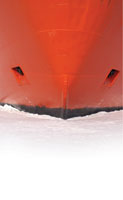
When the Titanic sank in 1912, dooming 1,500 of its passengers, it was far from the first vessel to fall prey to the icebergs that stalk the North Atlantic. And even with all the improvements to navigational safety that have been made since, ships are still at risk of unexpected encounters with a silent frozen menace.
Working with scientists from the National Research Council’s Canadian Hydraulics Centre and the Canadian Ice Service branch of Environment Canada, Stuart Savage, emeritus professor of civil engineering, helped develop a computational model to better predict an iceberg’s movement after being “calved” from the massive glaciers of Greenland.
Fed information on ocean currents, wind patterns and characteristics of the iceberg itself, the model should help ship captains avoid unwelcome surprises; the program will also be used to manage icebergs in the vicinity of oil-drilling platforms. Testing in the Grand Banks has shown the model to be at least 30 per cent more accurate than existing forecasting techniques.
Advances in ship design and navigational systems make another Titanic-sized catastrophe highly unlikely. However, notes Savage, icebergs are still a threat to ships and off-shore drilling projects. “Even a chunk of ice that’s just five or six metres in diameter can do a lot of damage,” he says. “What we want to do is to prevent the probability of a collision or an oil spill before it’s even a danger.”
This research was funded by Natural Resources Canada’s Program of Energy Research and Development, and the Natural Sciences and Engineering Research Council of Canada.
